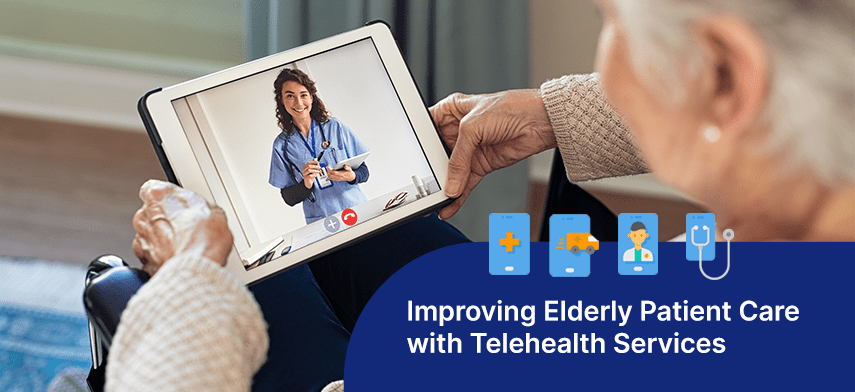For the past year, COVID-19 has entirely transformed human interaction dynamics. Senior citizens are among the most vulnerable part of the population, especially due to comorbidities in their bodies. This has given rise to older people relying on telehealth or virtual consultations to meet their doctors. Both physical and mental health today is important, but with the current situation, many seniors are unable to access healthcare services due to certain limitations.

According to the article published by CNN, 14% of people above 70 have dementia, apart from other chronic ailments, including vision impairments. Therefore, these sections of the population face a lot of difficulties when working with technological transformations. Additionally, remote monitoring for seniors with little to no knowledge of technology is very difficult to administer for physicians.
Obstacles in Senior Care Provision with Virtual Checkup Hike
Given the unprecedented situation that the pandemic has caused, doctors have taken to video conferencing platforms to check in on their patients. According to the study published by the Alliance of Community Health Plans and AMCP, 72% of USA citizens have changed how they consult doctors to online platforms. The same study also states that only 31% of the population feels comfortable visiting their doctor’s office.
Talking about the barriers in implementing home monitoring systems for seniors, it is worth noting that 23% of the seniors living in two-person households cannot afford necessities. That number rises to about 50%, taking into account the elderly that live alone. Hence, the people with monetary limitations or lack of access to the appropriate technology are at an increased risk of social isolation and health risks.
Communities falling under brackets of low socioeconomic status, people aged 85 and older, and people of color lack basic digital access. They constitute about a fourth of the population and this makes in-home monitoring systems for seniors unfeasible. These parts of the population have to resort to audio calls with their doctors to receive medical advice. The physicians charge the same rates as they would in video consultations, which puts these communities at a further disadvantage.
But, despite all these challenges and lack of adequate technology for the communities, as mentioned earlier, there is a silver lining. Patients find teleconsultation an excellent way to stay in touch with their doctors. Not only that, people who meet their doctors for the first time do seem to have a better interaction. It’s one of the most efficient methods since the risk of infection was reduced with in-home monitoring for seniors.
In the case of urologists with oncology patients, as revealed by the study mentioned above, the risk of infection was reduced, plus in-home monitoring for seniors became streamlined.
Various Aging Population Monitoring Systems
Doctors believe that video visits are better than audio visits because they show the patient’s house environment. Virtual visits also indicate the patient’s facial features, which lets the doctor see if they are dealing with any ailments. Caregivers are usually people located close to the patient and are associated with the organization. In some cases, they may also be nurses who act as mediators between the doctor and the patient.
There are four very notable systems used to administer telehealth access for senior care include:
1 Synchronous interaction
This essentially stands for real-time interaction between the two parties and is achieved through video call software. In addition to Zoom and Google Meet, platforms like Doxy, Vidyo, and VSEE are also being used by doctors for consultations.
2 Remote patient monitoring
Remote patient monitoring (RPM) allows doctors to monitor the vitals of people with asthma, heart diseases, or diabetes over a distance. This has also resulted in reduced costs in monitoring such vitals for senior patients.
3 Store and forward telemedicine
With the integration of cloud technology, the data of the patients can be collected and stored for later use. In addition, store and forward technologies allow clients to get their diagnoses at a lower cost and in good time.
4 Mobile health
Devices like smartwatches, phones, or tablets can measure the wearer’s heart rate, sugar, and blood pressure. This helps the consulting physician note the client’s readings over the conference and makes for better monitoring. Some devices can also monitor sleep cycles if necessary for a particular client.
User-friendly Healthcare to the Aging Population with Telemedicine Services
Not every individual categorized under the senior population are well informed about telehealth and its mechanisms. Many of them are appreciative of modern technology and are willing to explore how it works. It’s best to inform and educate them regarding telehealth virtual consultation services and let them gain confidence to access what telehealth has to offer.
For a smooth interaction during the consultation, tech support can be provided before the main call. This can be done by the support staff of the consulting organization. The best way to go about this process is by telling the older patients how to set themselves up over the telephone. Written and visual aids during the appointment are extremely helpful compared to verbal or auditory messages. It is here that the doctors need to be very understanding of the entire procedure.
Technology is a diverse utility-based platform with various applications and domains. Having a user-friendly app can help senior users to get accustomed to virtual consultations. First interactions usually take a little time as the entire concept is fairly new. It is important to acknowledge the transformation in healthcare delivery. The aging population is trying to understand and balance the need for telemedicine services, especially during this hard-hitting pandemic.
Easy to use interface, auditory and visual guidance, proper setup guidance, and assistance from the provider can help to elevate senior morale in trusting the telehealth process. This can help businesses in understanding consumer behavior and necessities.

Benefits of Telehealth Access for Senior Care
Following the detailed discussion on how telehealth works and the way people have responded to it, let’s cover how home health telemedicine or home monitoring for seniors is beneficial:
1 Time-saving and better efficiency
Patients and their family members no longer have to wait in long queues to visit the doctor. This saves them the time and energy needed to travel and avoids the hassle of waiting in long queues. It also helps providers treat patients better with in-depth analysis of the patient’s medical history and provided necessary care services and medication management.
2 Accurate disease management
Virtual sessions allow doctors to regularly check up on patients with chronic diseases and access their vitals in particular. This reduces the need to go in person if they can solve the problem over a video call.
3 Limited exposure to COVID-19
The aging population is restricted from traveling to the doctor’s chamber or visit the hospital to get medical advice, they are protected and are less exposed to the virus thanks to telemedicine services.
4 Increased accessibility to care delivery
Telehealth access for senior care allows patients to consult specialized doctors who live in different cities, or even abroad. Therefore, widening the care delivery accessibility. Seniors can connect with their specific providers across the globe, and receive the necessary treatment for their health conditions.
5 Improved patient data management
The patient records that are acquired by the consultants are protected to ensure that proper privacy is maintained. It is a simple and efficient method to maintain and manage patient’s medical data with telehealth services with EHR and HL7 integration platforms. These implementations can enhance patient data management swiftly and securely.
Telehealth Becoming a Promising Model for Senior Care Accessibility Post-COVID-19
Now, there are numerous advantages of implementing a telehealth model right now. Even in a post-COVID world, seniors won’t have to leave the comfort of their homes, and the decrease in wait time will be of huge benefit to them. The pandemic has forced an irreversible change in the health industry. Legislation concerning the privacy of patients has also been passed in some areas. HIPAA compliance is bringing in changes to the healthcare system, which in turn is debilitating in making telehealth access for senior care easier and efficient.
Final Thoughts
Telehealth is gradually enhancing the healthcare sector and there is a dramatic growth of senior care facilities with teleconsultation services. It helps both the providers and patients significantly and the overall healthcare system to grow beyond in-clinic and hospital visitations.
As telehealth and telemedicine services have been well-received, especially in the aging population category, healthcare is shifting towards an impactful shift in remote patient monitoring for seniors. The scope in telehealth is limitless, and implementing telemedicine access only enhances your business to grow further beyond your offerings. Therefore, telehealth will keep ensuring enhanced care delivery services even beyond the COVID-19 pandemic.

Author's Bio

Shailendra Sinhasane (Shail) is the co-founder and CEO of Mobisoft Infotech. He has been focused on cloud solutions, mobile strategy, cross-platform development, IoT innovations and advising healthcare startups in building scalable products.


